-
抗体試薬
- フローサイトメトリー用試薬
-
ウェスタンブロッティング抗体試薬
- イムノアッセイ試薬
-
シングルセル試薬
- BD® AbSeq Assay | シングルセル試薬
- BD Rhapsody™ Accessory Kits | シングルセル試薬
- BD® Single-Cell Multiplexing Kit | シングルセル試薬
- BD Rhapsody™ Targeted mRNA Kits | シングルセル試薬
- BD Rhapsody™ Whole Transcriptome Analysis (WTA) Amplification Kit | シングルセル試薬
- BD® OMICS-Guard Sample Preservation Buffer
- BD Rhapsody™ ATAC-Seq Assays
- BD Rhapsody™ TCR/BCR Next Multiomic Assays
-
細胞機能評価のための試薬
-
顕微鏡・イメージング用試薬
-
細胞調製・分離試薬
-
- BD® AbSeq Assay | シングルセル試薬
- BD Rhapsody™ Accessory Kits | シングルセル試薬
- BD® Single-Cell Multiplexing Kit | シングルセル試薬
- BD Rhapsody™ Targeted mRNA Kits | シングルセル試薬
- BD Rhapsody™ Whole Transcriptome Analysis (WTA) Amplification Kit | シングルセル試薬
- BD® OMICS-Guard Sample Preservation Buffer
- BD Rhapsody™ ATAC-Seq Assays
- BD Rhapsody™ TCR/BCR Next Multiomic Assays
- Japan (Japanese)
-
Change country/language
Old Browser
Looks like you're visiting us from {countryName}.
Would you like to stay on the current country site or be switched to your country?
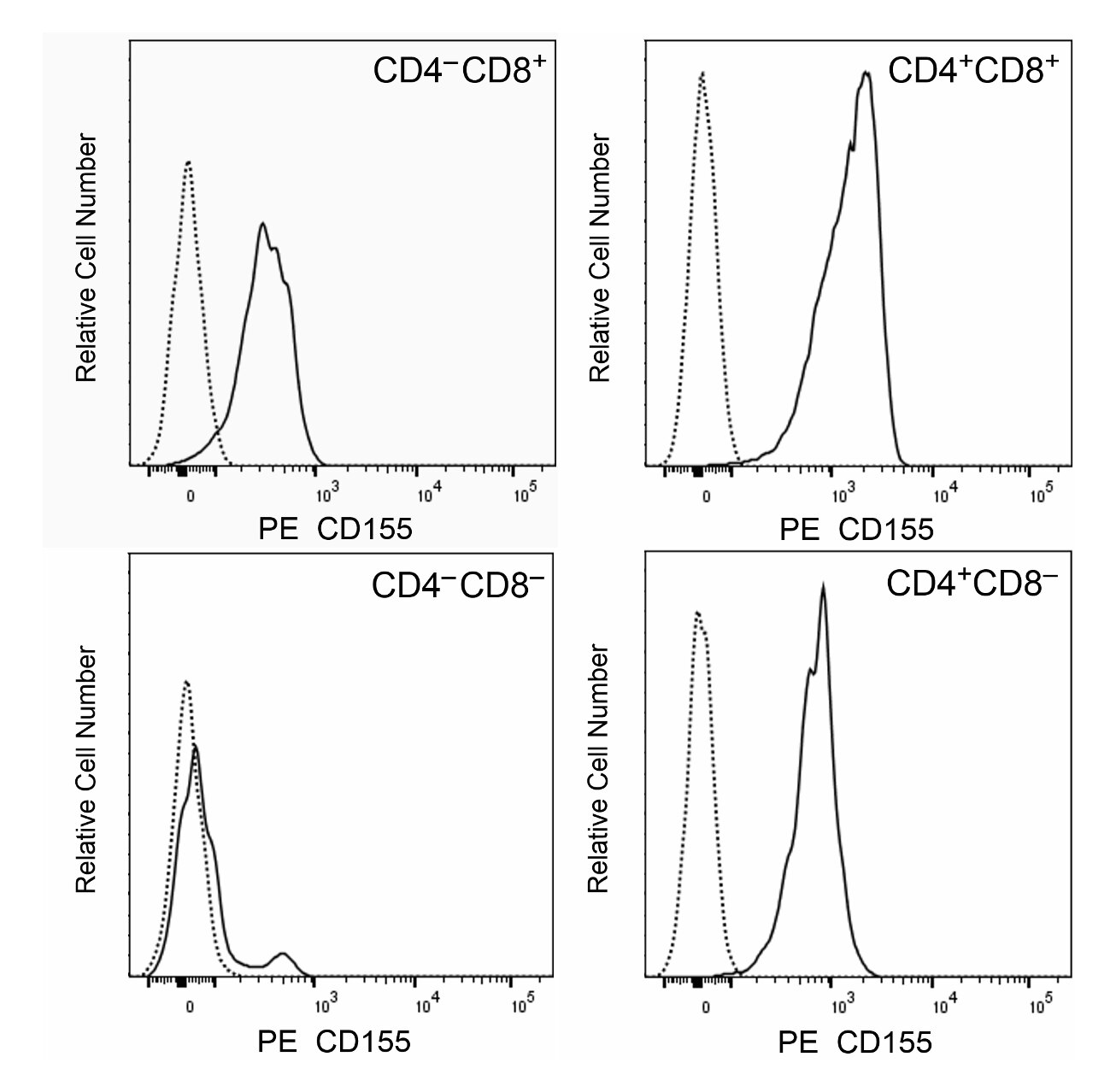

.png)

Multicolor flow cytometric analysis of CD155 expression on mouse thymocytes. C57BL/6 mouse thymocytes were preincubated with Purified Rat Anti-Mouse CD16/CD32 antibody (Mouse BD Fc Block™) (Cat. No. 553141/553142). The cells were then stained with FITC Rat Anti-Mouse CD8a (Cat. No. 553031/553030/561966) and APC Rat Anti-Mouse CD4 (Cat. No. 553051/561091) antibodies, and either PE Rat IgG2a, κ Isotype Control (Cat. No. 553930; dashed line histograms) or PE Rat Anti-Mouse CD155 antibody (Cat. No. 566719/566720; solid line histograms) at 0.5 μg/test. The fluorescence histograms showing CD155 expression (or Ig Isotype control staining) were derived from CD4-CD8+ (Upper Left Panel), CD4+CD8+(Upper Right), CD4-CD8- (Lower Left), or CD4+CD8- (Lower Right) gated events with the forward and side light-scatter characteristics of viable thymocytes. Flow cytometry and data analysis were performed using a BD LSRFortessa™ X-20 Cell Analyzer System and FlowJo™ software. Data shown on this Technical Data Sheet are not lot specific.
.png)

BD Pharmingen™ PE Rat Anti-Mouse CD155
.png)
Regulatory Statusの凡例
Any use of products other than the permitted use without the express written authorization of Becton, Dickinson and Company is strictly prohibited.
Preparation and Storage
Product Notices
- Since applications vary, each investigator should titrate the reagent to obtain optimal results.
- An isotype control should be used at the same concentration as the antibody of interest.
- Caution: Sodium azide yields highly toxic hydrazoic acid under acidic conditions. Dilute azide compounds in running water before discarding to avoid accumulation of potentially explosive deposits in plumbing.
- For fluorochrome spectra and suitable instrument settings, please refer to our Multicolor Flow Cytometry web page at www.bdbiosciences.com/colors.
- Please refer to www.bdbiosciences.com/us/s/resources for technical protocols.
関連製品
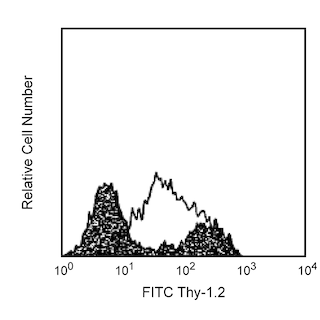

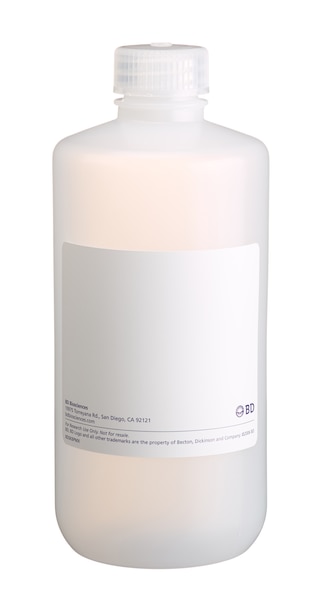
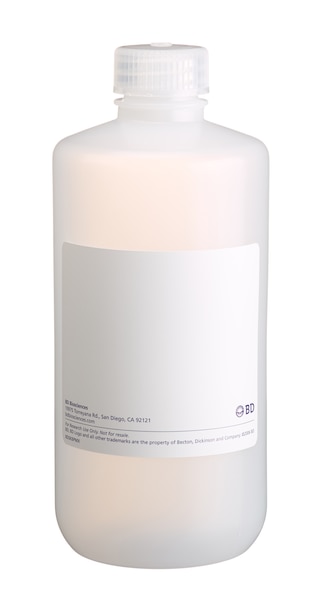
.png?imwidth=320)
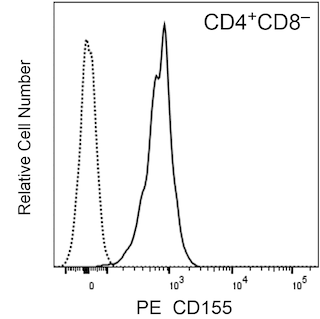
The TX56 monoclonal antibody specifically recognizes CD155, which is also known as Poliovirus Receptor (PVR), Tumor-associated glycoprotein E4 (Tage4), or Tumor-associated antigen 1 (Taa1). CD155 is a type I transmembrane glycoprotein that belongs to the Ig supergene family. CD155 is an adhesion receptor that binds to different ligands including nectin-3, CD96 (Tactile), CD226 (DNAM-1), TIGIT, and the extracellular matrix protein vitronectin. It is highly expressed on double-positive thymocytes and variably expressed on mature thymocytes and T cells, including regulatory T cells and NKT cells. CD155 is also differentially expressed on subsets of B cells, plasma cells, dendritic cells, and monocytes. CD155 expression is upregulated by activated T cells, B cells, and dendritic cells. CD155 is involved in forming adherens junctions between adjacent epithelial or endothelial cells. CD155 plays roles in regulating cell growth, adhesion, motility, migration as well as NK and T cell-mediated cytotoxicity.

Development References (7)
-
Danisch S, Qiu Q, Seth S, et al. CD226 interaction with CD155 impacts on retention and negative selection of CD8 positive thymocytes as well as T cell differentiation to follicular helper cells in Peyer's Patches.. Immunobiology. 2013; 218(2):152-8. (Biology). View Reference
-
Iguchi-Manaka A, Kai H, Yamashita Y, et al. Accelerated tumor growth in mice deficient in DNAM-1 receptor. J Exp Med. 2008; 205(13):2959-2964. (Clone-specific: Flow cytometry). View Reference
-
Iguchi-Manaka A, Okumura G, Kojima H, et al. Increased Soluble CD155 in the Serum of Cancer Patients. PLoS One. 2016; 11(4):e0152982. (Clone-specific: ELISA). View Reference
-
Kourepini E, Paschalidis N, Simoes DC, Aggelakopoulou M, Grogan JL, Panoutsakopoulou V. TIGIT Enhances Antigen-Specific Th2 Recall Responses and Allergic Disease. J Immunol. 2016; 196(9):3570. (Clone-specific: Flow cytometry). View Reference
-
Lenac Rovis T, Kucan Brlic P, Kaynan N, et al. Inflammatory monocytes and NK cells play a crucial role in DNAM-1-dependent control of cytomegalovirus infection. J Exp Med. 2016; 213(9):1835-1850. (Clone-specific: Flow cytometry, Immunofluorescence). View Reference
-
Stanietsky N, Rovis TL, Glasner A, et al. Mouse TIGIT inhibits NK-cell cytotoxicity upon interaction with PVR.. Eur J Immunol. 2013; 43(8):2138-50. (Biology). View Reference
-
Tahara-Hanaoka S, Shibuya K, Onoda Y et al. Functional characterization of DNAM-1 (CD226) interaction with its ligands PVR (CD155) and nectin-2 (PRR-2/CD112). Int Immunol. 2006; 16(4):533-538. (Biology). View Reference
Please refer to Support Documents for Quality Certificates
Global - Refer to manufacturer's instructions for use and related User Manuals and Technical data sheets before using this products as described
Comparisons, where applicable, are made against older BD Technology, manual methods or are general performance claims. Comparisons are not made against non-BD technologies, unless otherwise noted.
For Research Use Only. Not for use in diagnostic or therapeutic procedures.
Report a Site Issue
This form is intended to help us improve our website experience. For other support, please visit our Contact Us page.